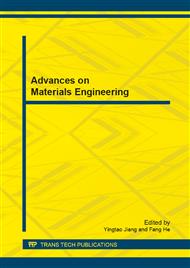p.117
p.123
p.128
p.133
p.141
p.146
p.151
p.156
p.161
Optimal Charge and Discharge Capacity Effects of the Sintering Process on LiMn2O4 by the Solid-State Reaction Method
Abstract:
This study investigates the optimal charge and discharge capacity of the sintering process on the lithium battery spinel - LiMn2O4. Both Li2CO3 and Mn3O4 are utilized to synthesize the cathode material LiMn2O4 using the solid-state reaction. Cathode materials are processed to fabricate batteries at temperatures ranging from 800°C to 900°C. Test results reveal that the highest initial discharge capacity of 105.19 mAhg-1 (theoretically at 148 mAhg-1) has been obtained at the temperature of 850°C in the sintering process for synthesis of LiMn2O4. In addition, the initial discharge capacity can be increased to 140.51 mAhg-1 with both overdosing the amount of lithium by 2% and increasing the range of operating voltage. The increasing of the charge voltage ranges from 4.5V to 4.8V and reducing of the discharge voltage ranges from 3.0V to 2.8V.
Info:
Periodical:
Pages:
141-145
Citation:
Online since:
August 2013
Authors:
Keywords:
Price:
Сopyright:
© 2013 Trans Tech Publications Ltd. All Rights Reserved
Share:
Citation:


